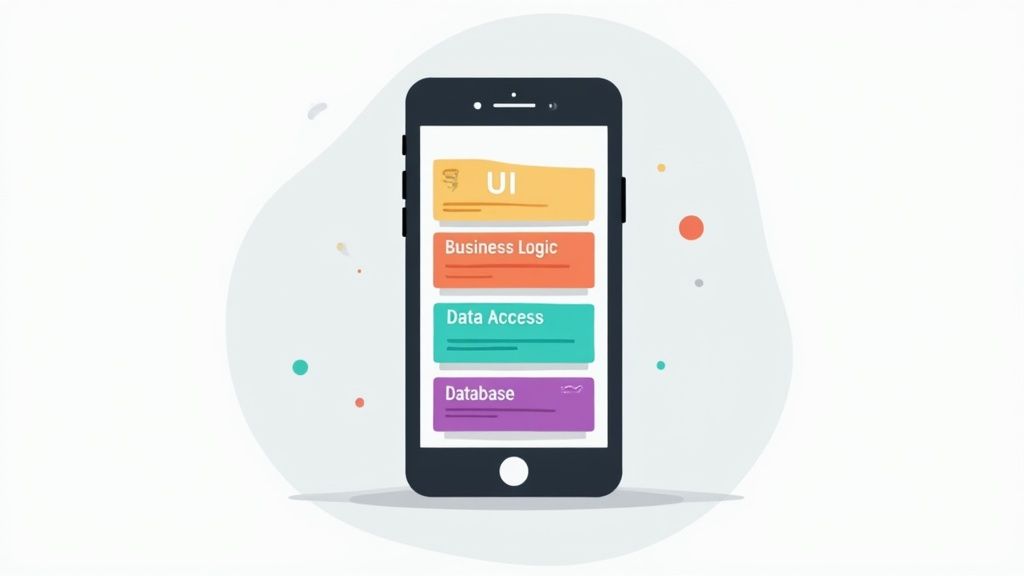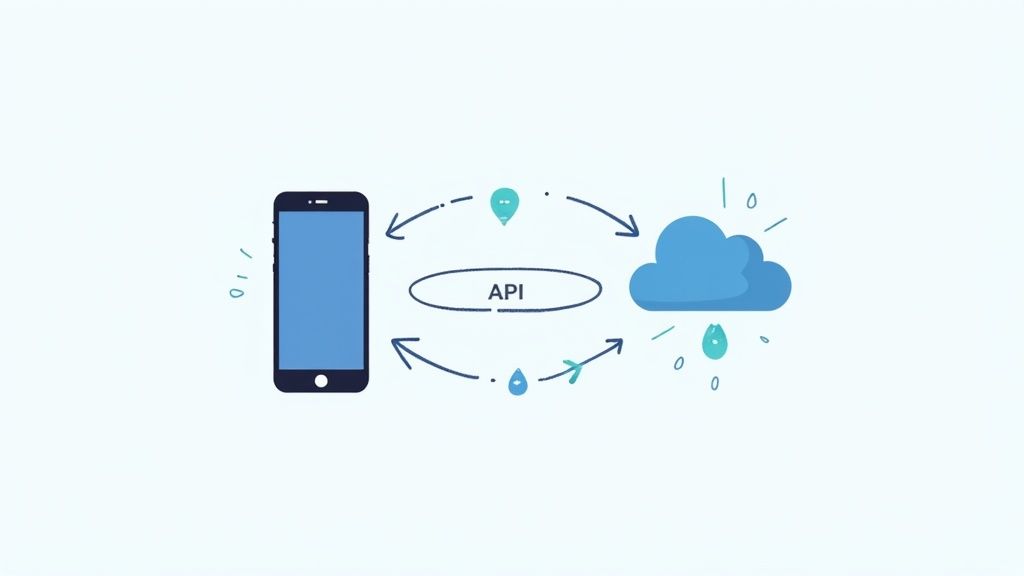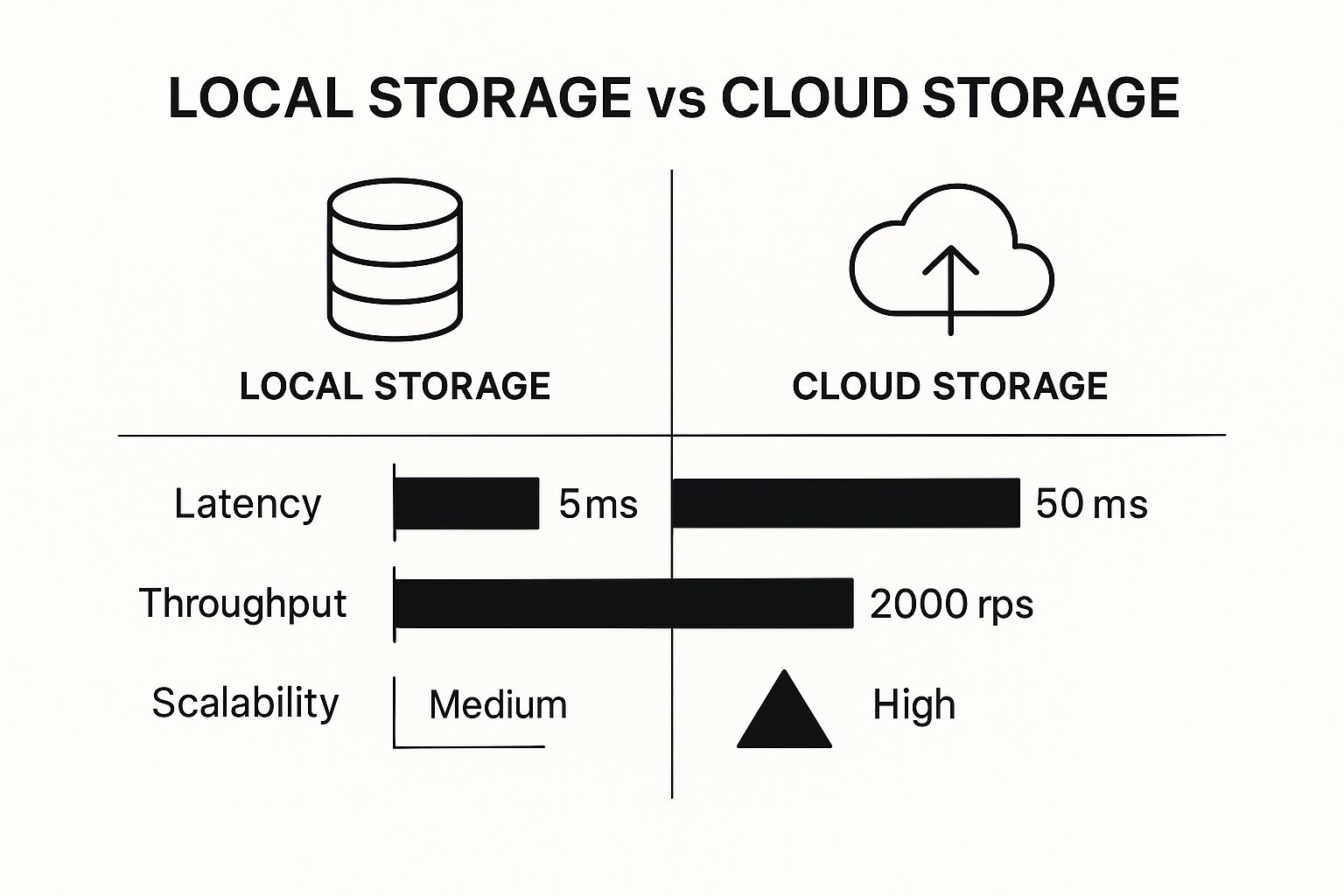The architecture of a mobile app is its fundamental blueprint, the master plan that lays out its entire structure and organization. Think of it like the architectural drawings for a skyscraper; it dictates how every single component—from the user interface down to the database—will connect and communicate. This strategic framework is what ensures your app is stable, scalable, and easy to manage throughout its life.
What Is Mobile App Architecture Anyway?

Before a single brick is laid for a new house, an architect drafts a detailed blueprint. That plan defines every room, hallway, and structural support, ensuring the final building is sound. The architecture of a mobile app plays the exact same role, but in the world of software. It’s the collection of patterns and techniques that form the very foundation of your application.
This foundation isn’t just about organizing code neatly. It’s a critical strategic decision that governs how your app behaves, determining everything from how data flows to how business rules are applied and how the app responds to a user’s touch. Without this solid plan, a project can quickly spiral into a tangled mess that’s a nightmare to debug, update, or expand.
The Real-World Impact of Good Architecture
A well-designed architecture has a direct and tangible impact on an app’s success. It influences performance, shapes the user experience, and determines how easily you can add new features without breaking what’s already there. A thoughtful structure is what makes an app feel snappy and responsive—a non-negotiable factor for keeping users engaged.
This isn’t just a technical detail; it’s a huge business advantage. In fact, well-architected apps are the engines driving the mobile economy. Projections show that mobile app revenue is expected to climb to an incredible $935 billion by 2025, a powerful testament to the value of high-performing, well-built applications.
“A mobile-first approach is also a content-first approach. Mobile has the most limitations—screen size and bandwidth, to name a few—and so designing within these parameters forces you to prioritize content ruthlessly.”
This idea of “ruthless prioritization” gets to the very heart of good architecture. By focusing on what’s truly essential, you build a stronger, more efficient, and ultimately more successful product.
A solid architectural plan from day one pays off in several key ways.
Why Solid Mobile App Architecture Matters
| Benefit | Impact on Your App |
|---|---|
| Enhanced Scalability | Your app can grow to handle more users and features without needing a complete, costly rewrite. |
| Improved Maintainability | Developers can find, fix, and update code easily, which dramatically reduces long-term costs. |
| Better Performance | A logical structure optimizes data flow, leading to a faster, more responsive user experience. |
| Increased Team Productivity | A clear plan allows multiple developers to work on different app components at the same time without conflicts. |
Ultimately, a strong architecture is the silent partner in your app’s success, providing the stability and flexibility it needs to thrive in a competitive market.
Why You Cannot Afford to Ignore It
Trying to build an app without a clear architecture is like constructing a skyscraper on a weak foundation. It might stand for a little while, but it’s doomed to face serious, structural problems down the road. Getting this right from the very beginning is non-negotiable for any serious app project, whether you’re building a native app or a progressive web app.
If you’re still weighing the pros and cons of different approaches, our guide on the differences between a mobile app versus a web app offers some valuable insights to help you decide.
Breaking Down the Core Architectural Layers

Every solid mobile app is built using distinct, organized layers. A strong architecture of a mobile app isn’t just a jumble of code; it’s a carefully structured system that keeps things from becoming a tangled mess. The best way to think about it is like a well-run professional restaurant. Every part of the operation has a specific job, and they all work together seamlessly without tripping over each other.
This idea of separating functions is a cornerstone of good development. It means a change in one area—like redesigning the menu—doesn’t force you to completely rebuild the kitchen. Let’s use this restaurant analogy to walk through the three main layers and see how they connect.
The Presentation Layer: The Dining Area
The Presentation Layer, often called the UI (User Interface) layer, is everything your user actually sees and touches. In our restaurant, this is the entire front-of-house experience: the dining room’s ambiance, the table settings, the menu’s design, and the server who takes your order. It’s the face of the operation.
In your app, this layer is made up of all the on-screen components:
- Buttons and controls users tap to get things done.
- Text and images that display information.
- Animations and transitions that give the app a polished, engaging feel.
The sole job of this layer is to show data to the user and capture what they do. It doesn’t need to know the complex logic behind the scenes; it just passes the user’s “order” to the next layer. The design here is critical—a clean, intuitive UI is a huge part of user satisfaction. These visual elements are a key component of any modern web designing layout and app development process.
The Business Layer: The Kitchen
Once an order is placed, it heads straight to the kitchen. This is the Business Layer (or Logic Layer), and it’s where all the magic happens. The kitchen staff isn’t worried about the dining room’s color scheme; their focus is on perfectly executing the order according to the restaurant’s recipes and standards.
This layer is the brains of your app. It takes requests from the Presentation Layer and applies all the business logic. This could be anything from validating a user’s password, performing calculations, or coordinating multiple steps to fulfill a request. For an e-commerce app, this is where you’d check if an item is actually in stock before letting a user complete a purchase.
By keeping business logic separate, developers can update rules and workflows without touching the user interface. This makes the app far more adaptable and easier to manage, since business needs are always changing.
For example, if you’re running a “buy one, get one free” sale, the Business Layer is responsible for applying that discount. The Presentation Layer just needs to show the final price; it doesn’t need to understand how that price was calculated.
The Data Layer: The Pantry and Suppliers
Even the best kitchen is useless without a well-stocked pantry and a network of reliable suppliers. This is the Data Layer, which manages every single data-related task for the app. Its job is to store, retrieve, and manage information, much like a pantry manager organizes ingredients and a procurement manager places orders for new supplies.
The Data Layer has two main functions:
- Data Persistence: This is all about storing data, whether it’s locally on the device (like in a SQLite database) or remotely in a cloud database. Think of this as the pantry, where ingredients are kept fresh and organized for easy access.
- Data Access: This function handles communication with outside sources, like fetching information from a server using an API (Application Programming Interface) or reading local files. This is like the kitchen getting a fresh delivery from its suppliers.
This layer provides the rest of the app with a consistent, reliable way to access the data it needs, without having to know the messy details of where it’s stored or how it’s fetched. This separation is absolutely essential for building a scalable and robust architecture of a mobile app.
Choosing Your Architectural Pattern
Once you’ve mapped out the layers of your app, the next big decision is picking a pattern to manage how they all talk to each other. This isn’t just some minor technical detail; it’s a foundational choice that will shape your entire development process and the future health of your code. Getting the architecture of a mobile app right from the start means your codebase will be clean, easy to test, and ready to grow.
Think of architectural patterns like organizational charts for a business. A tiny startup might do just fine with a flat structure where everyone reports directly to the founder—that’s your simple pattern. But a massive corporation needs a more complex, layered structure with clear departments and reporting lines to keep from descending into chaos. That’s your advanced pattern. Your job is to pick the structure that fits your project’s size today and its ambitions for tomorrow.
H3: MVC: The Foundational Pattern
The Model-View-Controller (MVC) pattern is one of the oldest and most recognized designs in the book. It was a revolutionary idea when it first appeared, introducing the concept of separating an application’s functions into three distinct but connected parts.
- Model: This is where your app’s data and business rules live. It’s in charge of managing the data and letting the View know when something has changed.
- View: This is simply the user interface (UI). Its only job is to show the user data from the Model and pass user actions—like a button tap—over to the Controller.
- Controller: This component acts as the go-between for the Model and the View. It takes user input from the View, tells the Model what to do, and then chooses which View to display next.
While it’s a solid starting point, classic MVC has a notorious weakness. The Controller often becomes a bloated “Massive View Controller,” trying to do way too much. This makes the code a nightmare to test and maintain, especially as the app gets more complex.
H3: MVP: A Clearer Separation
To solve the problems with MVC, the Model-View-Presenter (MVP) pattern was developed. It introduces a Presenter that takes a much more active role as the middleman, creating a cleaner break between the View and the Model.
In an MVP setup, the Presenter is responsible for grabbing data from the Model and preparing it perfectly for the View to display. The View becomes much more passive—it just shows whatever the Presenter gives it and immediately forwards all user events to the Presenter to handle. This makes the View (which is often tied to platform-specific code) much simpler and a whole lot easier to test.
The key difference here is that the Presenter communicates with the View through an interface. This completely decouples them, which means you can test your app’s core logic without ever needing to fire up a physical device or an emulator.
H3: MVVM: The Modern Standard
The Model-View-ViewModel (MVVM) pattern pushes this separation even further and has become a favorite for building modern, reactive apps. Its secret weapon is a powerful concept called data binding.
You can think of data binding as a “magic wire” connecting the ViewModel directly to the View. When data in the ViewModel changes, the View automatically updates itself without you having to write any extra code. The magic works both ways: when a user interacts with the View (like typing into a search bar), the data in the ViewModel is updated instantly.
The components break down like this:
- Model: Still the manager of all data and business logic, just like in MVC and MVP.
- View: The UI layer, which is now “bound” to the ViewModel.
- ViewModel: This component prepares and serves up data for the View. Crucially, it has no direct knowledge of the View, making it incredibly easy to test and reuse.
The mobile app architecture in 2025 is heavily influenced by these advanced patterns, which are essential for building scalable and maintainable apps. One major trend is Modular Architecture, which breaks large applications into smaller, independent modules. For native development, especially on Android, patterns like MVVM and MVP are king because they cleanly separate the UI from the business logic, dramatically improving testability. You can dive deeper into these trends in mobile app architecture on einfochips.com.
The image below touches on a related architectural choice that has a huge impact on your app’s performance: where you decide to store your data.

This comparison highlights the clear trade-offs between storing data locally on the device versus in the cloud. Local storage offers much faster access (lower latency) and higher throughput, while cloud storage provides unbeatable scalability.
H3: VIPER: The Special Operations Pattern
For truly massive and complex applications, particularly those being built by large development teams, even MVVM might not offer enough structure. This is where VIPER (View, Interactor, Presenter, Entity, Router) enters the picture. Think of it as the special operations unit of architectural patterns.
VIPER takes the idea of separation of concerns to the extreme, breaking down app logic into even smaller, hyper-focused components, each with a single job.
- View: Displays what the Presenter tells it and sends user actions back.
- Interactor: Contains the business logic for a single, specific use case.
- Presenter: Gets input from the View, uses the Interactor to perform business logic, and tells the Router when it’s time to navigate.
- Entity: Simple data models used by the Interactor.
- Router: Handles all navigation between the different screens of the app.
This intense level of separation makes VIPER incredibly scalable and testable. However, it also introduces a significant amount of complexity and boilerplate code. It’s a powerful tool, but it’s best saved for large-scale projects where having strict boundaries between components is essential for keeping the codebase under control.
H3: Comparison Of Mobile Architecture Patterns
Choosing the right architectural pattern can feel overwhelming. Each one has its strengths and is suited for different types of projects. To make the decision easier, let’s break down how they stack up against each other.
| Pattern | Best For | Pros | Cons |
|---|---|---|---|
| MVC | Simple apps, rapid prototyping | – Easy to understand – Fast initial development | – Can lead to “Massive View Controllers” – Poor testability in complex apps |
| MVP | Medium to large apps requiring better testability | – Highly testable Presenter – Clear separation of concerns | – More boilerplate code than MVC – Presenter can become oversized |
| MVVM | Complex, data-driven, reactive apps | – Excellent testability – Less code due to data binding – Reusable ViewModel | – Steeper learning curve – Can be overkill for simple apps |
| VIPER | Very large, complex apps with large teams | – Extreme separation of concerns – Maximum testability and scalability | – High complexity and lots of boilerplate – Significant initial setup time |
Ultimately, the “best” pattern is the one that aligns with your project’s complexity, your team’s familiarity with the concepts, and your long-term goals for the app. Starting simple with MVC and refactoring to a more advanced pattern later is a valid strategy, but for any serious project, considering MVP or MVVM from the get-go is often the wisest choice.
Key Pillars of a Modern App Architecture

A truly solid architecture of a mobile app goes way beyond just picking a trendy design pattern. It’s built on a few foundational pillars that make sure your app doesn’t just work on day one, but can actually grow and adapt over time.
If you ignore these pillars, you’re essentially building on shaky ground. It might look good at first, but sooner or later, the cracks will start to show. These core principles should guide every single technical decision, from your server setup to how you cache data on the device itself. Let’s dig into the non-negotiables that separate a fragile, short-lived app from a durable, long-term success.
Building for Scalability
Scalability is all about how gracefully your app handles growth. You need to build your architecture to support a million users, even when you only have ten. This isn’t about over-engineering everything from the get-go, but making smart choices now that prevent major headaches later.
Think of it like planning a road. For a small town, you might only need a two-lane street. But a smart planner buys enough land on either side to easily expand it into a six-lane highway without tearing down the whole neighborhood. That’s scalability.
For your app, this means a few things:
- Using a stateless backend: When your servers don’t store client-specific data, you can easily spin up more of them to handle traffic spikes without any drama.
- Choosing a scalable database: Opt for a database—whether it’s NoSQL or a managed SQL service—that can grow right alongside your user base without slowing to a crawl.
- Implementing a microservices approach: For more complex apps, breaking features into smaller, independent services is a game-changer. It allows you to scale just one part of your app (like user authentication) without touching the rest. This is common in large-scale systems, much like how a comprehensive ERP software implementation uses independent modules to support a growing company.
Optimizing for Performance
In the mobile world, speed isn’t just a feature; it’s everything. Users have zero patience for slow-loading screens or buttons that feel sluggish. A high-performance architecture is what makes an app feel snappy and fluid, even on a spotty network connection.
An app’s perceived performance is often more important than its actual speed. A user will forgive a 3-second load time if they see a loading indicator, but they will abandon an app that freezes for one second with no feedback.
Performance isn’t a single fix. It’s a combination of smart strategies:
- Minimizing network calls: Every trip to the server adds latency. Bundle your requests when you can, and only fetch the data you absolutely need right now.
- Enabling offline capabilities: A great app shouldn’t become useless without an internet connection. Caching data locally lets users keep working, and the app can sync everything up once it’s back online.
- Optimizing assets: Squeeze every kilobyte you can out of your images and use efficient data formats. This dramatically reduces load times and saves your users’ data plans.
Choosing the Right Development Approach
This is one of the biggest architectural decisions you’ll make. It directly impacts your budget, development timeline, performance, and what kind of user experience you can deliver. There are three main paths you can take.
- Native Development (iOS/Android): This is where you build two separate apps, one for each platform, using their native languages (Swift for iOS, Kotlin for Android). You’ll get the best possible performance and total access to every device feature, but it’s also the most time-consuming and expensive route.
- Cross-Platform Development (Flutter/React Native): Here, you write your code once and deploy it on both iOS and Android. This can drastically speed up development and cut costs. The trade-off is sometimes a slight hit to performance compared to a true native app.
- Hybrid/Progressive Web Apps (PWAs): These are essentially websites designed to look and feel like native apps, built with standard web tech like HTML, CSS, and JavaScript. PWAs offer incredible reach, and their market is projected to hit $10.44 billion by 2027. However, they usually come with the most limitations in terms of performance and accessing native device features.
Each approach has its place. A high-end gaming app will almost certainly go native. A startup with a content-heavy app might find cross-platform is the perfect balance of speed and cost. Your choice here sets the stage for the entire project, defining both the possibilities and the limitations of your architecture.
How Industry Giants Architect Their Apps
It’s one thing to talk about layers and patterns in theory, but seeing how they work in the real world is what makes everything click. The architecture of a mobile app isn’t some academic exercise; it’s a series of high-stakes decisions that power the apps you use every single day. For the giants of the industry, these choices are directly tied to their core business goals and the mind-boggling scale at which they operate.
Let’s pop the hood on a few household names. Seeing how their architectural decisions solve specific, monumental challenges turns abstract theory into practical, memorable lessons.
Uber’s Microservices Architecture
Ever wondered how Uber juggles millions of simultaneous ride requests, driver locations, and payments across the globe? A single, monolithic app would buckle under that kind of pressure. That’s why Uber built its backend on a microservices architecture.
Think of it like having a team of highly specialized experts instead of one person trying to do everything. In Uber’s world, different, independent services handle very specific jobs:
- Passenger Management: A service focused entirely on rider profiles and requests.
- Driver Management: A separate service that tracks driver locations, availability, and earnings.
- Trip Management: This service owns the entire ride lifecycle, from matching a rider and driver to completing the trip.
- Payments: A completely separate and highly secure service dedicated to processing fares.
This separation is the secret sauce. If the payment service has a hiccup, it doesn’t crash the ride-matching system. This approach is what allows Uber to scale, update, and maintain individual parts of its massive operation without causing a system-wide meltdown—something a business that runs 24/7 simply cannot afford.
A microservices architecture is all about resilience and agility. It lets different teams work on their services independently, deploy updates much faster, and slash the risk of a single point of failure taking down the entire app.
Netflix’s High-Throughput Streaming Engine
When you hit “play” on Netflix, you expect a perfect, buffer-free stream, whether you’re on a huge 4K TV or a phone with a spotty connection. Pulling this off is an engineering marvel, made possible by a robust client-server architecture designed for one thing above all else: unbelievable data throughput.
Netflix’s entire architecture is a masterclass in content delivery. The mobile app on your phone is a smart, sophisticated client, but the real magic happens on the backend. It all relies on a vast network of servers known as a Content Delivery Network (CDN).
A CDN works by storing copies of popular shows and movies on servers physically close to you. So, when you stream Stranger Things in Chicago, you’re probably getting that data from a server in Illinois, not from Netflix’s main data center in California. This simple-sounding idea drastically cuts down latency and ensures that silky-smooth playback we all expect. The app itself is built to talk to this network, smartly adapting video quality to your connection speed in real-time and even pre-loading what’s next. It’s a perfect example of architecture being shaped by a single, obsessive business goal: flawless video streaming.
Alright, let’s get down to the nitty-gritty. You’ve got the theory down—layers, patterns, the whole shebang. Now it’s time to turn that knowledge into a real, workable plan. Building a solid architecture of a mobile app isn’t some dark art; it’s a practical process that starts way before you write a single line of code. Think of this as your blueprint for making smart, deliberate choices that will pay off for years to come.
The whole thing kicks off with a simple question: What is this app actually supposed to do? Your business goals are the north star for every architectural decision you’ll make.
Start with Business Objectives
First things first, define what success actually looks like. Are you trying to get users hooked and keep them coming back? Or is it all about processing transactions securely and reliably? Maybe you just need to deliver data faster than anyone else. Each goal points you in a different architectural direction.
For example, an e-commerce app has to be rock-solid on security and reliability. A social media app, on the other hand, needs an architecture built for massive scale and real-time chatter. Once you have that clarity, you can start laying the groundwork.
A Practical Checklist for Architectural Design
This isn’t the final word on everything, but it covers the absolute must-dos for any development team. Consider this the foundation of your entire project plan.
- Identify Core Functionality: Make a detailed list of every single feature the app needs. Then, get real about your priorities. Use a method like MoSCoW (Must-have, Should-have, Could-have, Won’t-have) to figure out your Minimum Viable Product (MVP).
- Select Your Tech Stack: With your goals and features in mind, pick your tools. This means choosing the right programming language (like Kotlin or Swift), deciding on frameworks (React Native or Flutter), and figuring out the backend tech that will keep everything running.
- Choose an Architectural Pattern: Look at your app’s complexity. For a straightforward, data-heavy app, something like MVVM might be perfect. For a massive, complex project, you might need the structure of VIPER. This choice dictates how your code fits together and how your team works.
- Plan for Non-Functional Requirements: This is the stuff people forget until it’s too late. You have to plan for scalability, security, and performance from day one. Seriously, ask the hard questions now: How will the app handle 10,000 users at once? What security measures are in place to protect user data?
Architecture is not a one-time setup; it is an evolving foundation. Be prepared to revisit and refine your architectural decisions as your application grows, user feedback comes in, and new technological challenges emerge.
Thinking this way from the start ensures your architecture is a strength, not a weakness that will bog you down with technical debt later on.
Common Questions About Mobile App Architecture
When you’re kicking off a new project, it’s natural for both the dev team and the business stakeholders to have questions about the architecture of a mobile app. Getting these sorted out early saves a ton of headaches and costly fixes later. Let’s tackle some of the most common questions that pop up.
Is There One Perfect Architecture?
Nope. There’s no silver bullet or one-size-fits-all architecture. The “best” choice is the one that fits your specific project like a glove.
A simple app for delivering content might do just fine with a basic MVC pattern. But if you’re building a complex banking app, you’ll need the heavy-duty security and clear separation of something more advanced, like VIPER.
A few things will guide your decision:
- Project Complexity: How many features and moving parts are you juggling?
- Team Expertise: What patterns does your team already know and love?
- Scalability Needs: Are you planning for explosive user growth?
- Development Timeline: How fast do you need to get an MVP out the door?
The real goal is to find that sweet spot: an architecture that gives you enough structure to build on without bogging you down with unnecessary complexity.
How Often Should I Revisit My App’s Architecture?
Your architecture isn’t something you set in stone and then forget about. While you shouldn’t be ripping it up every other week, you definitely need to plan for reviews and potential tweaks at key milestones. This is especially true as your app starts to grow and change.
Think of your architecture as an evolving foundation, not a static blueprint. As your app grows, receives user feedback, and faces new technological challenges, your architecture must adapt alongside it.
Good times for a check-in are when you’re adding a major new feature, hitting performance snags, or bracing for a big jump in users. Being proactive here keeps technical debt from piling up and ensures your app stays healthy and easy to work on.
Can I Change My App Architecture Later?
You can, but it’s a massive headache and can get very expensive. Trying to swap out an app’s core architecture after it’s already built is like trying to replace a skyscraper’s foundation while people are still working on the 50th floor. It’s a huge, risky job that can unleash a torrent of bugs and grind new feature development to a halt.
This is exactly why spending time to nail down the right architecture of a mobile app from day one is so important. A well-thought-out initial structure gives you the wiggle room to adapt and expand later, saving you from a world of refactoring pain down the road.
Ready to build a high-performance, scalable mobile application with a rock-solid architecture? The team at KP Infotech specializes in creating custom mobile solutions that drive growth and deliver exceptional user experiences. Let’s discuss your project today!
